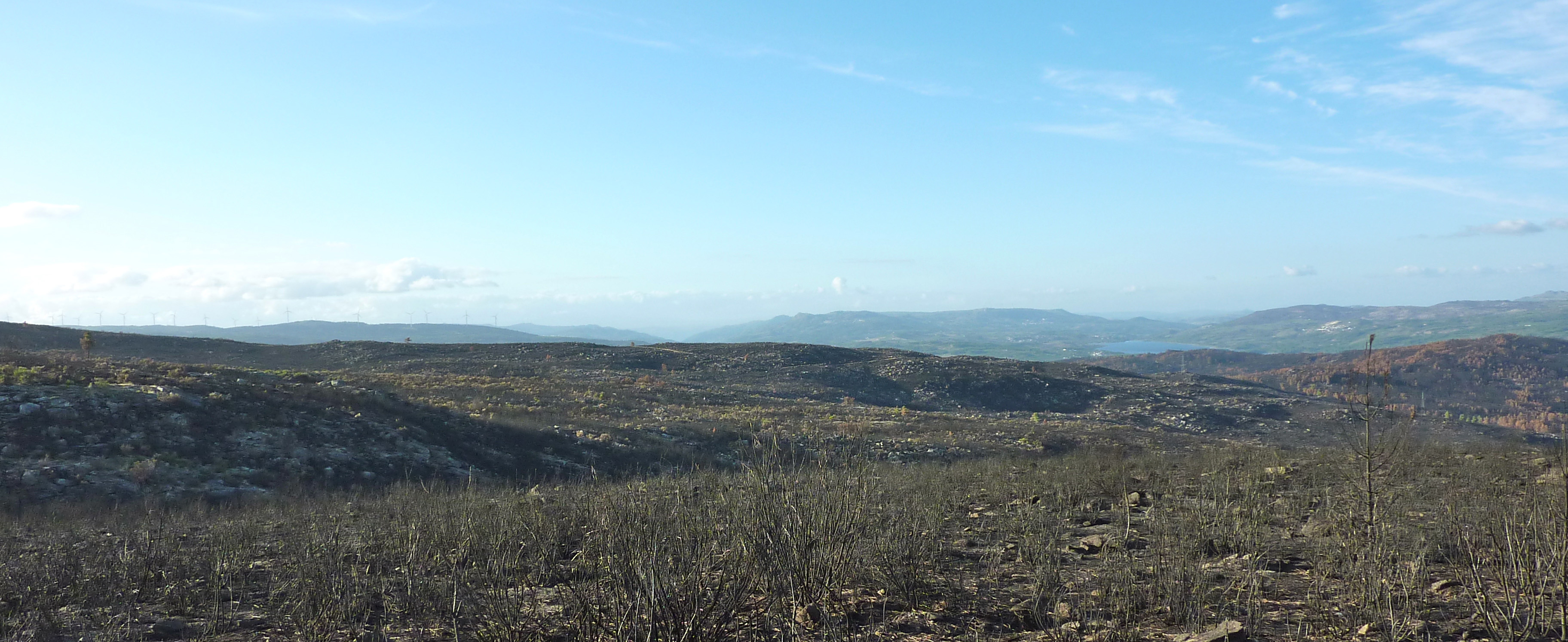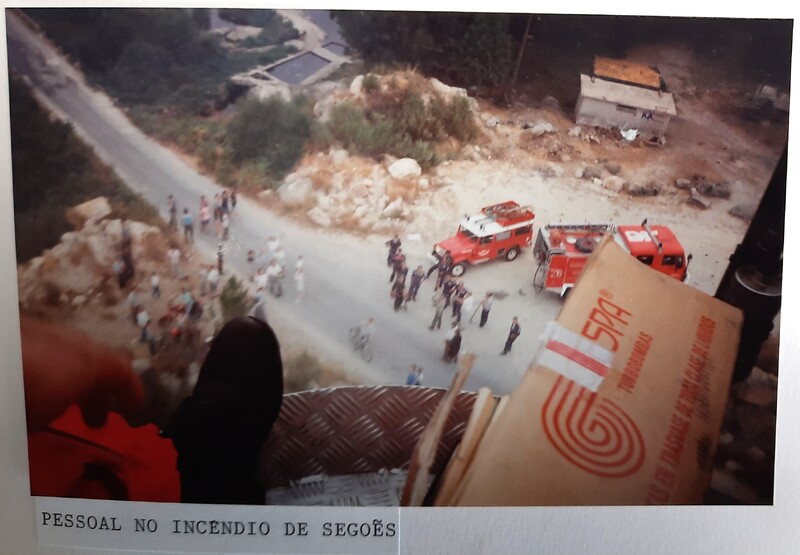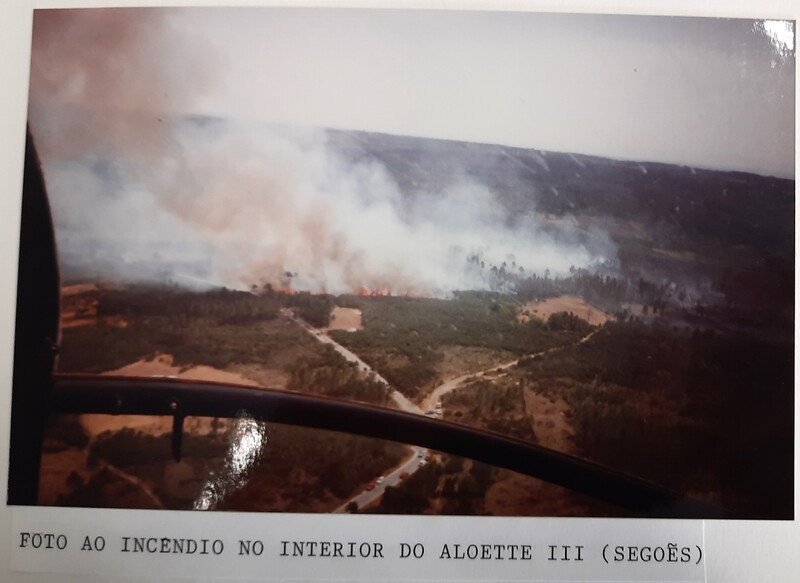Incêndios em Peva e Segões e participação popular | Fires in Peva and Segões and popular participation | aug 2023
Título | Title
Incêndios em Peva e Segões e participação popular | Fires in Peva and Segões and popular participation | aug 2023
Data | Date
4/08/2023
Notícia | News
No passado dia 4 de agosto, numa tarde com risco de incêndio “Muito Elevado”, com vento moderado (12 km/h) e humidade relativa muito baixa, cerca de 15%, alguns populares e 49 operacionais (de várias corporações de bombeiros da região e sapadores), apoiados por 13 veículos, que incluíam um helicóptero e uma pick-up da junta de freguesia, fizeram frente a um fogo que consumia floresta e mato na união de freguesias de Peva e Segões. No espaço de uma hora o incêndio entrou em fase de resolução, tendo ardido uma área de cerca de dois hectares. Precisamente 73 anos antes, a 4 de agosto de 1950, com dispositivos técnicos muito mais modestos ou inexistentes, a população de Segões combateu um “violentíssimo incêndio” que deflagrara nos 18 rolheiros (aglomerado de feixes de cereal, ainda com o grão) dispostos pela eira da igreja, enfrentando ainda um inesperado “vento desabrido”. De acordo com um ofício do então presidente da junta, “em poucos minutos, a eira era um mar de chamas. Aos repiques dos sinos acudiu a gente toda do lugar e dos povos limítrofes, Forles, Águas Boas, Alhais, Soutosa. Durante horas, servindo-se de todos os meios, carretando água das fontes e do rio, se deu combate ao incêndio”. Ao longo da pesquisa, os regulares registos incêndios nestas localidades paivotas e serranas, pontilhadas de espigueiros, eiras e terrenos baldios, têm nutrido a cronologia que o projeto FIREUSES está a construir. Estes registos têm-nos permitido verificar diacronicamente a
diversidade de origens do fogo, do seu desenvolvimento e extensão, das formas de combate e dos impactos. A participação popular no combate aos fogos é um dos pontos que tem requerido particular atenção. Em 1990, por exemplo, terá sido a ação concertada entre populares e bombeiros que impediu que um fogo posto em pinhal baldio alastrasse aos campos em redor e à povoação. A microhistória do fogo em Peva e Segões tem permitido conhecer melhor essa participação das populações locais e analisar os efeitos do afastamento das mesmas em relação ao fogo; quer o afastamento imposto por autoridades locais ou regionais, quer aquele ditado por novas dinâmicas populacionais e perceções pessoais ou comunitárias acerca do fogo, da sua ação e do território. As fotografias que publicamos foram gentilmente cedidas por Nuno Bondoso, Adjunto do Comandante dos Bombeiros Voluntários de Moimenta da Beira, e são datadas de meados dos anos 1990. Duas das fotografias foram tiradas a partir do Alouette III, helicóptero de apoio ao combate ao fogo.
On 4 August, on an afternoon with a “Very High” fire risk, moderate wind (12 km/h) and very low relative humidity (around 15%), a few local people and 49 operatives (from various fire brigades in the region and forest sappers), supported by 13 vehicles, including a helicopter and a pick-up truck from the parish council, tackled a fire that was consuming forest and scrubland in the Peva and Segões parish union. Within an hour, the fire was contained. The resulting burnt area was around two hectares. Precisely 73 years earlier, on August 4th, 1950, with much more modest or non-existent technical devices, the people of Segões fought a “very violent fire” that had broken out in the 18 big bundles of rye arranged around the church threshing floor, while also facing an unexpected “rough wind”. According to a letter from the president of the parish council at that time, “in a few minutes, the threshing floor was a sea of flames. At the ringing of the bells, everyone from the town and the neighboring villages of Forles, Águas Boas, Alhais and Soutosa came out. They fought the fire for hours, using every means, carrying water from the springs and the river”. Throughout our research, the regular records of fires in these mountainous villages, dotted with granaries, threshing floors and commonlands, have nourished the chronology that the FIREUSES project is building. These records have allowed us to diachronically verify the diversity of the origins of fire, its development and extent, the ways in which it was fought and its impacts. Popular participation in firefighting is one of the points that has required particular attention. In 1990, for example, it was the concerted action of local people and firefighters that prevented an arson fire in a common land pinewood from spreading to the surrounding fields and to the village. The microhistory of the fires in Peva and Segões has made it possible to learn more about the participation of the local population and to analyze the effects of their distancing from the fire; both the distancing imposed by local or regional authorities and that dictated by new population dynamics and personal or community perceptions about the fire, its action and the territory. The photographs we are publishing were kindly provided by Nuno Bondoso, Assistant Commander of the Moimenta da Beira Volunteer Fire Brigade, and date from the mid-1990s. Two of the photographs were taken from the Alouette III, a firefighting helicopter.
diversidade de origens do fogo, do seu desenvolvimento e extensão, das formas de combate e dos impactos. A participação popular no combate aos fogos é um dos pontos que tem requerido particular atenção. Em 1990, por exemplo, terá sido a ação concertada entre populares e bombeiros que impediu que um fogo posto em pinhal baldio alastrasse aos campos em redor e à povoação. A microhistória do fogo em Peva e Segões tem permitido conhecer melhor essa participação das populações locais e analisar os efeitos do afastamento das mesmas em relação ao fogo; quer o afastamento imposto por autoridades locais ou regionais, quer aquele ditado por novas dinâmicas populacionais e perceções pessoais ou comunitárias acerca do fogo, da sua ação e do território. As fotografias que publicamos foram gentilmente cedidas por Nuno Bondoso, Adjunto do Comandante dos Bombeiros Voluntários de Moimenta da Beira, e são datadas de meados dos anos 1990. Duas das fotografias foram tiradas a partir do Alouette III, helicóptero de apoio ao combate ao fogo.
On 4 August, on an afternoon with a “Very High” fire risk, moderate wind (12 km/h) and very low relative humidity (around 15%), a few local people and 49 operatives (from various fire brigades in the region and forest sappers), supported by 13 vehicles, including a helicopter and a pick-up truck from the parish council, tackled a fire that was consuming forest and scrubland in the Peva and Segões parish union. Within an hour, the fire was contained. The resulting burnt area was around two hectares. Precisely 73 years earlier, on August 4th, 1950, with much more modest or non-existent technical devices, the people of Segões fought a “very violent fire” that had broken out in the 18 big bundles of rye arranged around the church threshing floor, while also facing an unexpected “rough wind”. According to a letter from the president of the parish council at that time, “in a few minutes, the threshing floor was a sea of flames. At the ringing of the bells, everyone from the town and the neighboring villages of Forles, Águas Boas, Alhais and Soutosa came out. They fought the fire for hours, using every means, carrying water from the springs and the river”. Throughout our research, the regular records of fires in these mountainous villages, dotted with granaries, threshing floors and commonlands, have nourished the chronology that the FIREUSES project is building. These records have allowed us to diachronically verify the diversity of the origins of fire, its development and extent, the ways in which it was fought and its impacts. Popular participation in firefighting is one of the points that has required particular attention. In 1990, for example, it was the concerted action of local people and firefighters that prevented an arson fire in a common land pinewood from spreading to the surrounding fields and to the village. The microhistory of the fires in Peva and Segões has made it possible to learn more about the participation of the local population and to analyze the effects of their distancing from the fire; both the distancing imposed by local or regional authorities and that dictated by new population dynamics and personal or community perceptions about the fire, its action and the territory. The photographs we are publishing were kindly provided by Nuno Bondoso, Assistant Commander of the Moimenta da Beira Volunteer Fire Brigade, and date from the mid-1990s. Two of the photographs were taken from the Alouette III, a firefighting helicopter.

Serra da Lapa, 6 de agosto de 2020


